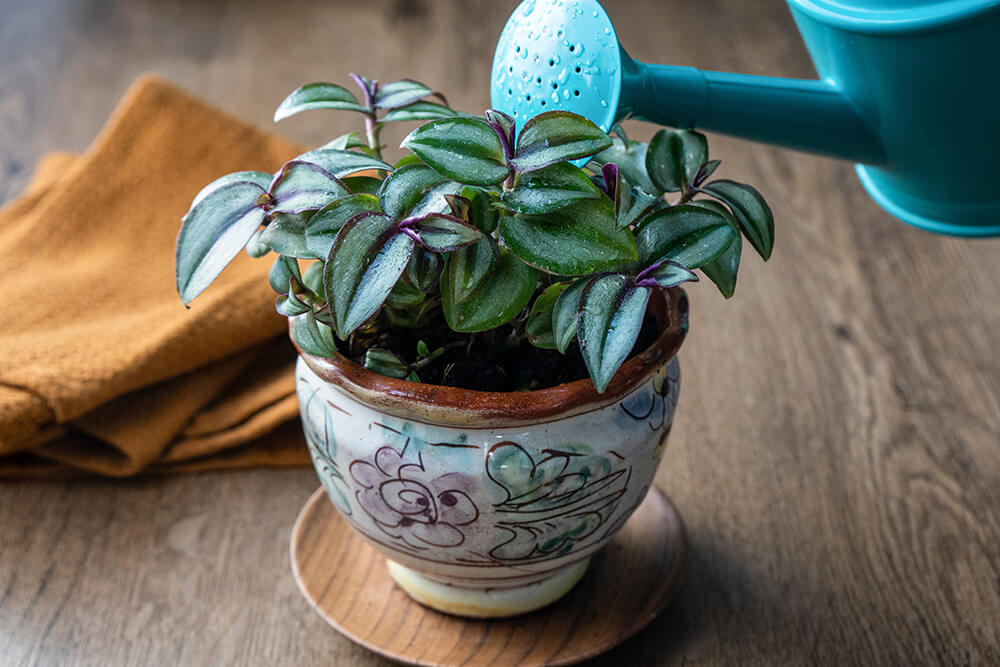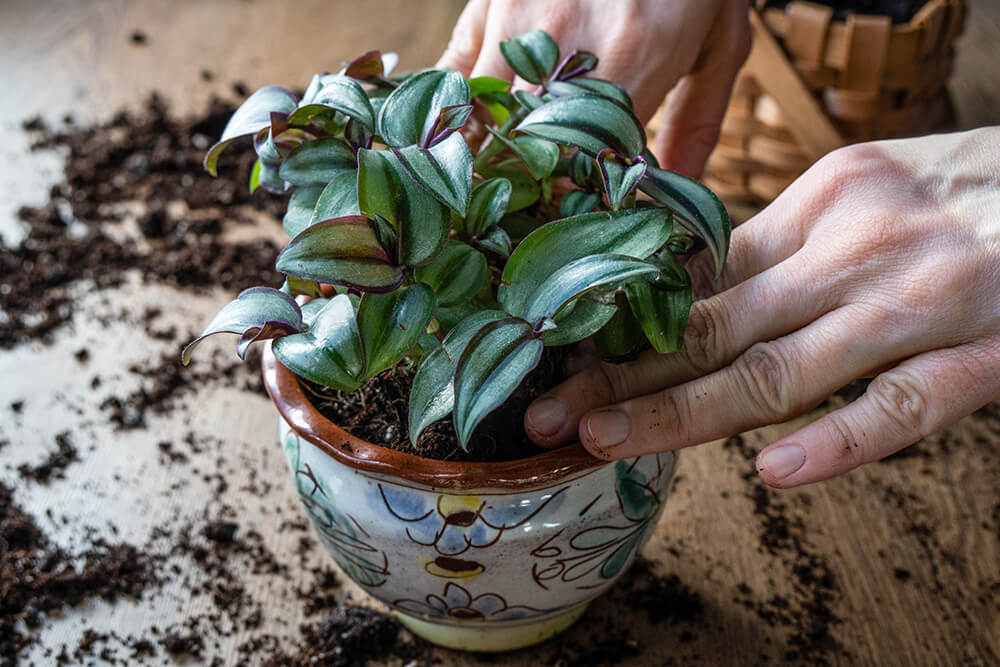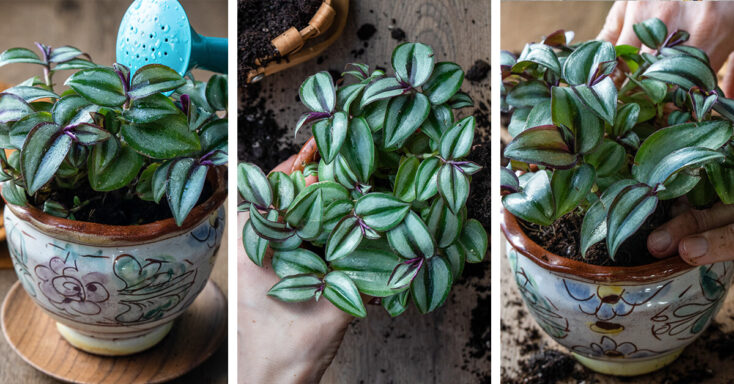Tradescantia zebrina, commonly called the Wandering Jew plant, is a striking houseplant known for its variegated leaves tinted with green, silver, and purple. It originated in Central America and Mexico’s tropical regions. So, the Zebrina is a perfect choice for growing indoors. The good news is that Wandering Jew plant care is not difficult at all!
Key Takeaways
- Zebrina is a low-maintenance, fast-growing plant.
- The Zebra Plant makes an excellent choice for beginner gardeners because care isn’t overly complex.
- This plant quickly fills up empty spaces in your indoor landscaping efforts.
- Pruning is good for Zebrinas. It maintains their shape and keeps them from becoming invasive.
Wondering about the Wandering “Dude”
The Zebrina has numerous nicknames (many from cultivars), including Silver Inch Plant, Striped Trad, Striped Wandering Creeper, Purple Heart Plant, Small Leaf Spiderwort, Moses in the Cradle, and Zebra Plant. Because the name Wandering Jew is offensive to some, gardeners usually use one of these, the botanical name, or the new moniker, Wandering Dude.
The flowing leaves on this plant measure about ½ inch long and about ¼ inch wide. When used outdoors, they make a colorful ground cover. The flowers are pink to purple and bear brownish seeds. Take care when you work with the zebra plant. The sap proves irritating to some people.
Light Play: When Zebrina is in bright light, the colors become even more vibrant. If you have a window location with indirect light, the exposure enhances leaf pigments. It is very visually appealing.
The Basics of Wandering Jew Plant Care (Zebrina)
In taking care of any indoor plant, there are certain important points in your care routine.
- Temperature: Zebrina plants thrive when the temperature is around 70 degrees. Keep the plant away from drafts or air conditioning ducts.
- Light: South or eastern-facing windows work best, provided the light is indirect. If they’re not getting enough sun, they become spindly.
- Water: Keep your inch plant moist. Avoid over-watering or letting the plant’s soil dry out completely.
- Soil: Plant your Wandering Dude in a peat-based potting mix with good drainage.
- Humidity: Good news! The average humidity in your home should work fine.

The Battle of Fronds vs. Flowers: Many people buy houseplants for their flowers. Zebrinas do produce delicate petals, which look charming. However, the true allure of the Wandering Dude is its foliage.
Wandering Jew Plant (Zebrina) Needs
When you’re looking for a beautiful backdrop to your indoor garden efforts, Zebrina fills that need. Mix the type of container you use for greater visual impact. You can take your plants for a summer stroll, but you cannot leave them outdoors during winter.
Except for Purple Queen Zebrina, which loves direct light, the fronds of these plants will burn if left in direct sunlight for too long. If you have a window that gets light in the morning and indirect light later, the Wandering Dude will thrive.
Tip: Turn your pots periodically so all sides of the plant benefit from sunlight.
If you’d like to expand your Zebrina family, propagation is simple. It begins with taking a stem cutting. Look for a healthy stem and snip it below a node. You can then root it in a glass of water or put it directly into the soil. A little rooting compound improves the results from direct soil planting.
Choosing a Wandering Jew Plant for Your Home
Inch Plant (blossfeldiana): Thick, fuzzy leaves with purple undersides. It blossoms in flower clusters of white, rose pink, or blue. Mature height 6-12 inches.
Longpipes (Wild Crocus): These bluish-purple flowers appear from May until June. It’s thin, arching leaves grow up to 7 inches long. If you have a rock feature inside, longpipes will do well there.
Moses-in-a-basket (Oyster Plant; Boat Lily): The dark green leaves are sword-like and grow in a spiral. The undersides of the foliage are purple, and it blossoms with white flowers. Dwarf plants are 6-12 inches tall and require 6-8 hours of indirect light daily. The vibrant purple undersides of this plant’s leaves are truly striking.
There are two popular variants of Moses-in-a-Basket. One is a Tricolor, bearing pink, green, and cream leaves. The other is a Golden Oyster with bright gold-yellow leaves.
Pallida: A native of Mexico, Pallida goes by the name Purple Heart. The foliage is eggplant purple, adorned with light pink flowers bordering on orchid—a good choice for hanging baskets. Grows 1-2 feet tall and wide.
Striped Inch Plant (River Spiderwort, Speedy Henry): Average size is 12” x 12”. The plant’s leaves are dark green, shiny, and pointy (2 inches). Striped inch plants blossom with white flowers.
Virginia Spiderwort: Bright green narrow leaves topped with violet, three-petaled flowers that measure 2” across. Each flower only lives for a day, but there are so many you won’t notice. This is a larger member of the Wandering Jew family, with an adult height of 18-20 inches and a width of 12-18 inches.
White Velvet: Gray-green leaves covered in white hairs distinguish this Wandering Jew from others. It blossoms for about a month in bright pink-purple flowers. Received the Award of Golden Merit from the Royal Horticultural Society. Mature height: 12 inches.
While humans suffer no illness from Zebrina, ingestion by pets can be toxic. Keep this in mind when placing them around your indoor garden.
Wandering Jew Plant Watering Techniques

While these plants handle random overwatering, it won’t continue being healthy if left waterlogged too long. When you apply water, do so from the base of the plant. Watch and you can see the water absorption. Alternatively, you can take the plant to your sink and give it a good bottom watering until the liquid comes out of drainage holes. Let it finish in the sink, then put it back in place.
When you walk through your home, regularly check your plant’s soil. Put your finger down to the ½ inch point in the soil. If it’s dry, then water. Because your Wandering Jew may grow at different rates throughout the year, this test alleviates guesswork.
If you are busy and may forget, try an aqua globe.
Vertical Space: If you want a plant to fill some of your vertical space, you’ll be happy to know Zebrina can be trained. By using a support, you can guide it toward climbing. Use a moss pole or trellis as a support system.
Wandering Jew: Potting and Repotting
Tradescantia are fast growers, so you may need to repot it every two or three seasons. When it’s time, you want to give the plant a larger container and fresh soil. Zebrina’s roots will start peeking out of drainage holes to tell you they need more space. Alternatively, they may move up the side of the pot toward the container’s edge.
When you remove the plant from the current container, begin by putting it down on its side. Hold the pot with one hand and the base of the foliage with the other. Gently wiggle (the stems can be quite delicate). Once it slides out, shake off old soil and inspect for signs of disease or pests.

As a generalization, Zebrina represents adaptability, growth, and resilience. Because of its hardy nature, this plant has become a metaphor for overcoming adversity and showing grace during times of transformation. It is an emblem of the human spirit’s perseverance and enduring hope. In literature, the flower appears as a symbol of beauty, strength, faith, and diligence.
Dream books say the Wandering Jew appearing reminds you all is not lost. Stay true, stand tall, and succeed. If you’re holding the flower, it portends luck and prosperity.
Pruning and Maintenance
Because this plant grows quickly, heavy pruning is good for it. Make it an addition to your regular Wandering Jew care routine. Trim off long tendrils, dead leaves, and weak growth. Pinch off new growth and thin it out. This helps create a bushy appearance and transforms the plant into something suitable for your indoor efforts.
Sometimes, per their name, Zebrina goes a-wandering. It becomes leggy stems with few leaves. Keep those trimmed down so the plant can focus its energy more effectively. If you’re plants look rather dull, trimming is the trick for promoting thick leaves.
Perhaps the most important reason for pruning Wandering Jews is to keep them healthy. Removing unhealthy or dead parts deters fungus and disease.
When: Indoor plants often follow nature’s lead, resting during fall and winter. So, give them their haircut in spring or early summer at the latest.
Zebra Plants and Therapeutic Properties: Inch plants have antioxidants and antimicrobial properties. In areas like Jamaica, people treasure them as a treatment for high pressure and cough while applying leaves for swelling. In China, this plant has the name “Water Turtle Grass.” It’s recommended for kidney disorders. Mexicans have an inch plant leaf decoction used as a tonic. Along the same lines, Guyana healers brew the leaves and offer the tea for influenza and digestive issues.
Blooming and Resting Periods
This plant’s flowers benefit from a dormant period the previous winter. Since it’s indoor, you’ll need to put the Zebrina in an area hovering around 60F. Reduce water. You want the soil to dry for two weeks between irrigation. Always use room-temperature water so you don’t shock your plants.
Once the Wandering Jew is growing, you’ll need to water it once a week. Now is the time for fertilization.
There is a legend that surfaced in the 13th century. It says that a Jewish person taunted Jesus on his way to crucifixion. As a result, the person was cursed to walk the earth until the second coming. Another sad account was that of a condemned man separated from his sister by the Bering Straight. He set out to find her, yet wherever he traveled, plagues followed. There is no happy ending here. The fellow never finds his sister.
There is no question that the Wandering Jew is diligent and sometimes invasive, so perhaps some of those characteristics contributed to the plant’s name.
Common Pests & Plant Diseases
Wandering Dudes rarely have pests indoors. Occasionally, you may find aphids or spider mites. You can wash both off the leaves or use a natural insecticide.
When you see small white webs on the undersides of leaves, that’s a spider mite. They like it warm and dry, so amp up the humidity using a household humidifier near the plant. Spray it periodically. Should the critters persist, wash the plant in your sink.
Signs of Aphid infestation include:
- Weakened growth
- Yellowing, twisting, or curling leaves
- Galls
- Small white flakes on the leaves (this is the result of aphids shedding their exoskeleton)
- A sticky, shiny substance on leaves and stems (honeydew)
- Black, sooty mold (a result of honeydew)
- Diseased plants (aphids carry over 100 different viral diseases that can settle into the Wandering Jew)
Neem oil is a trusted remedy. Apply, then re-apply in a week. Continue more applications until they’re gone.
When it comes to disease, most develop because of over-watering, which leads to root rot. Roots can only retain so much water before they start getting mushy. The good news is you can remedy this easily. Reduce your watering schedule and improve the drainage in the soil. Just add some coarse sand or perlite.
Black patches and white powdery particles on your plant’s leaves reveal fungal issues like leaf spots, botrytis, and powdery mildew. Clean away affected foliage. Make sure your plant isn’t over-watered. If you get stuck and the fungus won’t go away, you should dispose of the Wandering Jew and sterilize the container before reusing it.
In an odd twist, you can grow wandering jew plants in water. You will need to change the water every 4 days and add a little fertilizer (3:1 ratio in freshwater). Using purified water is best. Salt and chlorine can adversely affect these plants. Also, make sure the water is at room temperature. With the right lighting, you can keep Zebrina alive in water for a long time, much like money plants.
Troubleshooting Common Wandering Jew Problems
- Bare stems and spindly growth: Over the years, this is natural. However, in younger plants, it may indicate a lack of light, water, or fertilization.
- Loss of leaf color: When variegated leaves begin turning all green, your plant is getting too much direct sunlight.
- Limp stems: Typically means a lack of water, but could be a sign of insects.
Word Play: The Inch Plant’s name is descriptive to a T. This foliage grows approximately one inch every week! It can also propagate itself using only an inch of stem.
Frequently Asked Questions About Jew plant
Does a wandering Jew plant need sun?
Yes, but not direct sun. An area with indirect light is best for these plants. Turn the plant periodically so all sides get filtered light regularly.
How do you care for a wandering Jew indoors?
Now, you may have Wandering Jews that are just indoor plants. But if you have outdoor pines, you; 'll need to bring them into your home before the threat of frost. They’ll do just fine in your household landscape as long as you give them adequate light and proper watering.
How often do you need to water a wandering Jew plant?
If your Wandering Jew develops mushy stems, you’re over-watering it. Don’t automatically bring over the water pail. Check the soil. If it’s dry down to 1”, it’s safe to add moisture. Otherwise, wait.
How long will wandering Jew last?
Wandering Jews are fairly hardy. As long as you care for them correctly, your Tradescantia plants will live for many years.
How big do wandering Jews get?
Much depends on the type. Most plants don’t grow beyond one foot tall but may have longer (2-foot) stems.
Summary
Zebrina plants have a rich history and a variety of interesting traits. It thrives in a variety of environments, and has alluring striped leaves, and people enjoy looking at it. When you want to add some living greenery to your indoor garden, Zebrina is one possibility. It’s exotic yet understated, and you will enjoy it for years to come.


